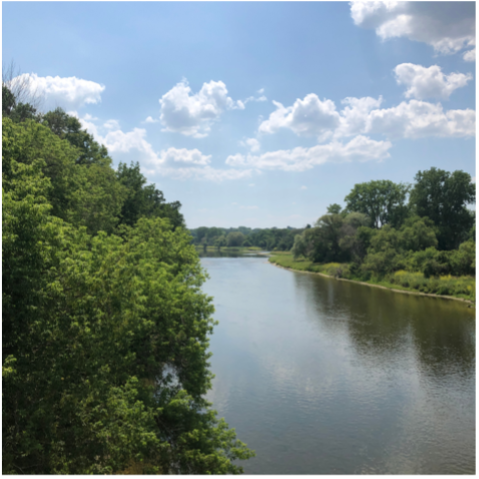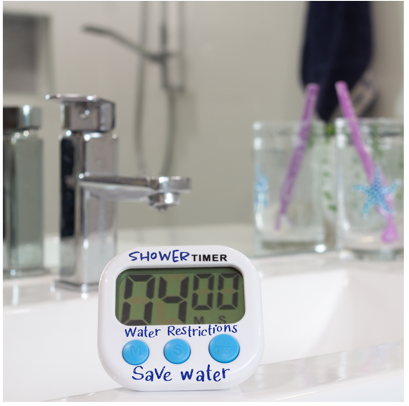Summer is in full swing, which likely means many trips to the swimming pool, water park (if they reopen), watering our gardens, and other activities on top of everyday water-using tasks like washing dishes, taking showers, flushing toilets, and more. As you can imagine, we tend to use a lot of water at this time of year, so the Sustainability Office is exploring ways we can reduce our personal water consumption for the month of July.
Why does water conservation matter?

It’s hard to imagine a world without an abundant supply of fresh, clean water when many of us have been so used to it throughout our lives. But what if one day you turn the tap on and suddenly no water comes out? This is an unfortunate reality for many people around the world; according to the United Nations (2020), 2.2 billion people do not have access to safely managed drinking water, whereas 785 million people are without even basic drinking water.
Canada may have the most freshwater resources in the world – 20% of the world’s total, to be exact. But only 7% of that 20% is available for human use, which is drawn from lakes and underground aquifers. In addition, despite having the most freshwater in the world, it is inaccessible to most Canadians because 85% of us live along the southern border, whereas this water drains into the Arctic Ocean and Hudson Bay thousands of kilometres away. This means that there is a lot of pressure on a small amount of freshwater, which is unequally distributed across the country.
This imbalance in water accessibility has led to numerous unfortunate events. A prominent example is from Walkerton, Ontario in 2000 when a massive E.coli outbreak in drinking water resulted in the death of hundreds of citizens. Water insecurity is also an ongoing among Indigenous Nations across Canada: in 2015, there were drinking advisories in 126 First Nations communities.issue of water insecurity has been amplified during the COVID-19 crisis, and 73% of First Nations’ water systems are at serious risk of contamination.

Looking locally to Waterloo Region, the majority of our drinking water comes from the Grand River and underground aquifers. These underground water sources need time to replenish, so when we place a lot of pressure on them (i.e., use a lot of water), they can deplete. Especially when facing extended periods of dry weather (and potentially drought), the stress these aquifers face is amplified. We therefore need to be smart about our use of this water: we must be mindful of our consumption, using only what we need, when needed, so our aquifers don’t get depleted. Conserving water is one piece of the puzzle to ensuring the long-term sustainable use of our freshwater resources for everyone.
Ways to conserve water
Water conservation can take many forms, so whether you live in residence, a student apartment/condo, or in a house, there is something everyone can do to protect our precious water resources. Two approaches of water conservation include reducing water demands and reusing water. Note that these approaches overlap significantly, and you should take measures to both reduce and reuse water.
Reduce
-
Turn the taps off. Do you leave the tap on while brushing your teeth? Turning the taps off can save over 30 litres of water every day – that’s 60 water bottles.

- Water less and at certain times. Did you know certain times of day are better to water your lawns than others? Only water at dusk and dawn to minimize evaporation. In addition, as of May 31st, 2021 the Region implemented its annual Water Conservation By-Law, meaning you can only water your lawn once per week based on where you live.
- Check pipes for leak. If your pipes have even a hole 1/16 inch that leads to leaking, this can waste 3,570 litres of water in just 24 hours – that’s 7,140 water bottles!
- Check toilets for leaks. Toilets are even worse than pipes, which can waste up to 20,000 litres of water in 24 hours – that’s 40,000 water bottles! To test for toilet leaks, put a few drops of food colouring in the toilet tank and wait 10-15 minutes. If the dye appears in the bowl, it means you have a leak
Reuse
- Save greywater. Reuse water from cooking, laundry, and showers to water your plants.
- Plant a rain garden. These beautiful gardens help to manage stormwater, recharge our local water table, protect pollinators and promote local biodiversity.
- Install a rain barrel. Another way to capture and reuse rainwater is to install rain barrels, which can save over 4,900 litres of water – that’s 9,800 water bottles in savings.
Learn more about water conservation
Now that you know some of the ways you can help protect our water resources, check out these campus and community resources to support your water conservation efforts.
- Explore the Sustainability Office’s Water webpage to learn more about what the University is doing to conserve water
- Check out the University’s own Water Institute for all the latest research on water sustainability
- Read the new Waterloo Conservation By-Law to know when to water your lawn in Waterloo Region
- Create a rain garden using Reep Green Solution’s Beginners Guide to Building a Rain Garden
- Learn about water conservation in the Region and province by reading the Grand River Source Water Protection Plan and Ontario Clean Water Act
- Keep an eye out later this month for a special episode on WAT’s Sustainable? where we have an in-depth conversation with Reep Green Solutions about water conservation!
Everyone plays an important role in protecting and preserving our water. Every action we take, from brushing our teeth to watering our lawns, does make a difference. Our challenge to you: find at least one way every day to save water. Try shortening your shower by one minute or more. Reuse cooking water, or capture rainwater to water your garden. The possibilities are endless, and all are impactful!